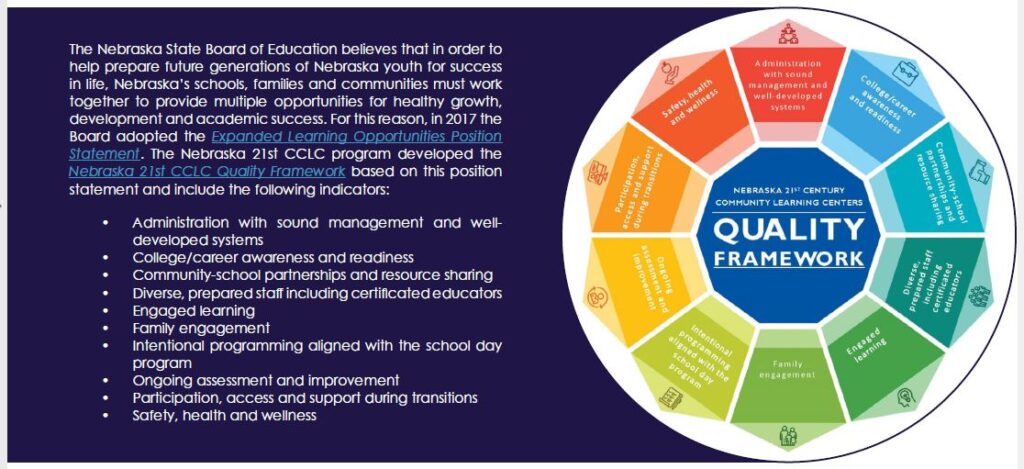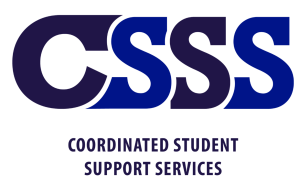Before-School, Afterschool, and Summer Programs
Nebraska School, Family, and Community Engagement Framework
Out-of-school time (OST) programs are regularly scheduled, structured, and supervised activities where learning opportunities take place outside the school day. These age appropriate programs can occur within a school or at a community based site before-school, afterschool, or during the summer. OST programs provide safe environments for youth and resources for families.
 The Nebraska State Board of Education believes that in order to help prepare future generations of Nebraska youth for success in life, Nebraska’s schools, families and communities must work together to provide multiple opportunities for healthy growth, development and academic success. For this reason, in 2017 they adopted the Expanded Learning Opportunities Position Statement. The Nebraska 21st CCLC program developed the Nebraska 21st CCLC Quality Framework based on this position statement and include the following indicators:
The Nebraska State Board of Education believes that in order to help prepare future generations of Nebraska youth for success in life, Nebraska’s schools, families and communities must work together to provide multiple opportunities for healthy growth, development and academic success. For this reason, in 2017 they adopted the Expanded Learning Opportunities Position Statement. The Nebraska 21st CCLC program developed the Nebraska 21st CCLC Quality Framework based on this position statement and include the following indicators:
- Administration with sound management and well-developed systems
- College/career awareness and readiness
- Community-school partnerships and resource sharing
- Diverse, prepared staff including certificated educators
- Engaged learning
- Family engagement
- Intentional programming aligned with the school day program
- Ongoing assessment and improvement
- Participation, access and support during transitions
- Safety, health and wellness
It is the goal of OST programming to improve academic outcomes for all learners. A 2020 study by Afterschool Alliance examined the effects of early childhood education and afterschool activities found that both higher quality early child care and afterschool programs in the elementary years (K- 5th grade) are associated with higher reading comprehension and math achievement scores in high school. The effects were cumulative, with children who participated in both experiencing increased benefits.
Because staff play such an important role in implementing a high quality OST program and connecting with families and children, it is important to provide ongoing professional development to ensure a diverse, prepared staff.
Practice: Intentionally build and support collaborative relationships with schools, local community members and leaders, businesses, and community-based organizations committed to partnering with before, afterschool and summer programs. These important partnerships support program planning, implementation, and funding for program improvement and sustainability.
Exemplar: Beyond School Bells developed a resource to assist programs identify local partners (both likely and unlikely) and tools to utilize in order to build collaborative relationships and enhance program offerings.
Exemplar: The 21st CCLC Partner Spotlight highlights the work of organizations committed to partnering with OST programs across Nebraska. Featured partners have demonstrated a commitment to working with program leaders and staff to identify ways to mutually accomplish identified goals. Contact the featured partners to explore the possibilities for bringing unique and engaging learning opportunities to children and youth.
Exemplar: North Platte Public Schools Kids Klub asks families for their place of work and uses this information to talk to businesses about how Kids Klub is supporting their employees and creating new partnerships.
Practice: When appropriate, invite community partners and family members to site-level leadership team meetings. Quality OST program leaders can also form community/parent advisory groups to provide direction and guidance while assisting a program toward its goal of continuous improvement. Community partners and family members can bring knowledge, experience, and a variety of perspectives to an OST program.
Exemplar: The Nebraska 21st CCLC program requires a Site-Level Management Team, that includes the school building principal and program leader, meets regularly (at least four times per year) to discuss program strengths, needs and data collected.
Exemplar: Every Hour Counts is a coalition of OST providers that created a Measurement Framework and Putting Data to Work Guidebook that can assist site-level management teams and advisory groups when analyzing data.
Practice: Provide time outside of the regular school day for students to connect in meaningful ways with program staff, school-day educators, colleges/universities, and local business and industry partners to develop interests and skills for future success. OST experiences are planned based on students’ interests, available community resources and identified student needs.
Exemplar: Provide programming that allows students to explore potential career paths. NDE provides resources and virtual career tours on their CTE Career Fields & Career Clusters page. Beyond School Bells also has career units for OST surrounding six different fields.
Practice: Provide a safe, healthy and nurturing environment for all students. The physical space and the atmosphere of the program promote a healthy learning environment. Program staff should be prepared to address situations as they arise to ensure students’ safety. Health and nutrition are incorporated into daily programming, and there are daily opportunities for physical activity.
Exemplar: OST programs conduct regular safety drills, including fire and tornado. The OST program leader is part of the district or school Safety Committee and all staff participate in relevant in service training.
Exemplar: Program leaders provide ongoing professional development to assure a safe, healthy learning environment for students. Resources that provide relevant professional development include You for Youth (Y4Y), 4-H Extension, C.A.T.C.H., and the NDE Early Childhood Training Center.
Practice: Offer an inviting OST environment where families feel welcome, promote positive communication with families, and support meaningful family engagement in the educational experiences of students. Incorporate regular opportunities for family members to be engaged in program planning and implementation.
Exemplar: Provide opportunities for families to be meaningfully engaged in the program including ongoing communication with families in their primary language. Examples of ways to engage families in the program include:
- Opportunities for family members to volunteer in the program
- Utilize a Parent Advisory Board to provide program input
- Implement a School, Neighborhood Advisory Committee (Lincoln Community Learning Centers SNAC)
Afterschool Alliance discusses the barriers and benefits of family engagement through afterschool programs. One of the largest benefits is that afterschool programs can help break down barriers between schools and families because of the unique way OST programs interact with both partners. Additionally, they point out that there are distinct categories of family engagement and that programs need to acknowledge and honor all types of family engagement.
The Nebraska 21st CCLC statewide evaluation team collects data that is compiled into an annual report. Data includes survey results from school day teachers, families, students, staff and community partners. Additionally, the United States Department of Education (USDE) provides a national overview of performance data for the 21st CCLC programs. This site explains what is measured and provides links for the most recently published data.
When “Promoting Engagement in Afterschool,” programs should focus on 3 principles: shared responsibility, connection, and continuity. This helps to “create a more equitable approach to family engagement based on family strengths.”
This study from the National Institute on Out-of-School Time (NIOST), shows how out-of-school time programs can positively impact the families of students who were served. Notably, students are the ones initiating change in their families based on their experiences in the OST program.
Community Schools
- The National Center for Community Schools has resources and strategies for building successful community schools that help transform schools “into vital hubs that benefit students, their families and the surrounding community.” This graphic shows how the 4 pillars of community schools work together to support all learners.
- This framework from the Institutes of Educational Leadership and the Coalition for Community Schools provides schools with actionable steps to improve their schools and provides examples of successful community schools in action.
- Heather Weiss, M. Elena Lopez and Margaret Caspe highlight how communities are shaping learning anywhere, anytime for children and youth in this blog.
Improving OST Programs and Activities
- The National Center for Families Learning (NCFL) provides support and resources for families to engage with their students at home. Learning Outside of School and Family Engagement Activities contain examples of the OST activities and resources that NCFL provides.
- The Charles Stewart Mott Foundation focuses on three main areas when it comes to advancing afterschool efforts: building an afterschool infrastructure, fostering afterschool policy, and improving afterschool quality & innovation.
Engaging Families in OST Programs
- This resource created by the Harvard Family Research Project and BOSTnet focuses on building family-centered practices in afterschool.
For engaging families who have students with disabilities, this article from Understood.org has some great suggestions for OST providers.





